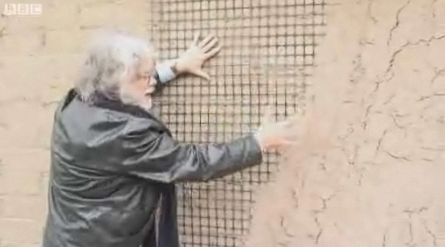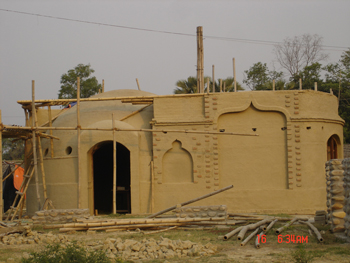Construction manual for earthquake-resistant houses built of earth by Gernot Minke.
Low-Cost Reinforcement of Earthen Houses in Seismic Areas by M. Blondet, J. Vargas and N. Tarque.

Architecture, Design, and Culture using of mud, clay, soil, dirt & dust.
Construction manual for earthquake-resistant houses built of earth by Gernot Minke.
Low-Cost Reinforcement of Earthen Houses in Seismic Areas by M. Blondet, J. Vargas and N. Tarque.

Specialist earth builder, President of the Earth Building Association of Australia, and guest researcher in the Faculty of Engineering and Information Technology, Peter Hickson, has combined one the world’s most ancient building techniques, “cob” construction, with modern engineering methods to develop a model house as part of an effort to createlow cost earthquake resistant housing for millions of people around the world. Hickson’s house introduces many new technologies, but what makes his system unique structurally is the addition of internalbamboo reinforcing and the use of structural diaphragms. Read more about Hickson’s research.

Since 1970, Peru has been hit by five powerful and deadly earthquakes. The latest struck Peru’s coast exactly two years ago with a magnitude of 8.0 on the Richter scale. It fiercely shook the capital Lima, but its devastating epicentre was about 200km (124 miles) to the south, near the town of Pisco, a small fishing port built largely of adobe – mud bricks which Peruvians have used for thousands of years. For Peruvian engineer Marcial Blondet, it was the devastating quake in 1970 that first motivated him to develop earthquake-resistant buildings, particularly for those who could least afford them. Mr Blondet and his team found a solution in an industrial plastic mesh used by mining companies to hold back earth on slopes. It is strong, cheap and easy to use. Securely enveloping a normal mud-brick home in the mesh can prevent the walls from collapsing in an earthquake. The building wobbles but it does not fall down.

Abari, a socially and environmentally committed research,design and construction firm that examines, encourages, and celebrates the vernacular architectural tradition of Nepal. In this recent project, the dome will be covered with bamboo roof as a protection again heavy tropical rain. The adobe structure is reinforced with bamboo to make it earthquake resitant. This structure is a reception of community structure, which is also being built.

photo by Marcial Blondet
On Wednesday evening an 8.0 earthquake struck central Peru, devastating the Ica region of the Andean country. The official death toll from this unfolding disaster currently stands at 502 [as of 16 Aug — Ed.]; around four hundred of these were residents of Pisco, a city of over 100,000 near the epicenter of the main quake. Pisco is reported to have lost 80 percent of its homes.
Peru’s La Republic reported that Palomino had cautioned and warned homeowners not to rebuild their homes on their own despite the fact that they may have no other choice after so much neglect. Despite this, citizens in Pisco, Peru are informally building adobe houses as a way of recovering after the earthquake.
Dr. Marcial Blondet, a professor of at the Pontificia Universidad Catolica de Peru, an expert on seismic design for earthen buildings has written Earthquake-Resistant Construction of Adobe Buildings: A Tutorial as well as a number of important text on the performance of mud brick in earthquake zones, particularly in Peru. More resources about earthen architecture in seismic zones and the Peru earthquake can be found at the Earthquake Engineering Research Institute website.